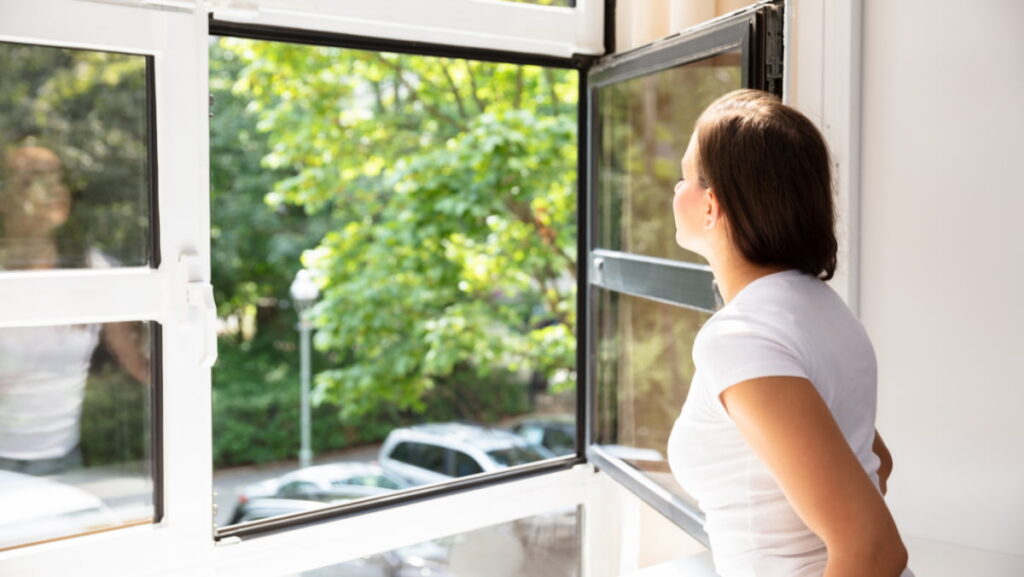
On a sunny day, basking by the window might feel like the perfect way to catch some rays. But can you actually tan through a window? To put it simply, yes, but it’s not as effective as tanning outdoors.
Windows block a good amount of UVB radiation, which is responsible for sunburns and increasing your risk of skin cancer. However, they can’t filter out all UVA radiation, which causes tanning and skin aging.
Although you’re less likely to get sunburnt through a window, UVA rays still penetrate the glass, potentially damaging your skin in the long run. Unprotected sun exposure, even through windows, can cause premature skin aging, contribute to wrinkles, and increase your risk of skin cancer.
Now that you know tanning through a window is possible but also carries risks, it’s important to be aware of sun exposure in everyday activities.
Let’s dive deeper into the main question, “Can you tan through a window?” because the answer isn’t as simple as you may think.

Can You Tan Through A Window?
The impact of the sun’s rays on an individual while sitting by a window depends on numerous factors, including the window’s proximity, the duration of exposure, and the intensity of sunlight.
According to the American Cancer Society, typical home, office, and car windows block most UVB rays but a smaller amount of UVA rays. But ordinary glass, which you still can find in older homes, for example, offers less protection.
So how does this work exactly? One main factor to consider is the type of glass used in your window. Glass comes in various forms:
| Glass Type | UVA Rays Passing Through (%) |
|---|---|
| Clear glass | 70-75% |
| Laminated & Tempered | 95% |
| Low-E windows | 5% |
On top of that, you also need to consider the following two points in order to find out if you can tan through your window:
- Distance Between You and the Window: The closer you are to the window, the more directly the sun’s rays will hit your skin. However, if you’re farther away, the angle of the sun’s rays may change and reduce the intensity of the exposure.
- Duration of Exposure: The longer you’re exposed to sunlight through a window, the greater the potential for tanning. It’s important to note, however, that even extended exposure through a window may not produce the same level of tanning as direct exposure outdoors.
Besides the type of glass, sunlight also plays a big part. Sunlight consists of three types of ultraviolet (UV) rays: UVA, UVB, and UVC.
While UVC rays are absorbed by the Earth’s atmosphere, UVA and UVB rays reach the surface and are responsible for tanning and sunburns. UVA rays penetrate deeper into the skin, causing long-term damage, while UVB rays primarily cause sunburns and skin reddening.
Windows, specifically glass ones, usually block a significant amount of UVB rays but allow most UVA rays to pass through. Here’s an approximate breakdown of the percentage of UVA and UVB rays that pass through standard glass windows:
| Type | UVA Rays | UVB Rays |
|---|---|---|
| Glass Windows | 75% | 0-5% |
Considering these numbers, you’ll find that tanning through a window might be possible to some extent, but it’s not as effective as direct exposure to sunlight.
Can You Get A Sunburn Through A Window?
Yes, it is indeed possible to get a sunburn through a window, although the likelihood depends on various factors, such as the type of window, time of day, and the strength of the sun.
Sunburns are more likely to occur when there is prolonged exposure to the sun, especially on days when the UV index is high. UV rays are known to be most intense during midday, typically between 10 a.m. and 4 p.m.
However, it’s important to consider that what lies beyond the window can also affect your risk of sunburn. This is because UV rays have the ability to bounce off certain surfaces, thereby increasing your overall exposure. Surfaces such as water, sand, and snow are particularly known for reflecting UV rays.
In essence, if you have a splendid view outside your window, spending an extended period of time there on a sunny day increases your chances of getting a sunburn. It’s crucial to be aware of these factors and take appropriate precautions to protect your skin from harmful UV radiation.
Do You Still Get Vitamin D Through A Window?
Unfortunately, windows generally block out UVB rays, which are responsible for the production of vitamin D in the skin. Vitamin D, often called the “sunshine vitamin,” is absorbed when the skin is exposed to UVB rays.
Simply put, UVB rays are absorbed by the skin, leading to the conversion of cholesterol into vitamin D. Therefore, if you wish to obtain vitamin D from sunlight and enjoy its numerous benefits, direct skin exposure to the sun is the best approach.
According to experts, it is recommended to expose at least one-third of your skin (such as by wearing shorts and a tank top) directly to sunlight for 10 to 30 minutes three times a week to maximize vitamin D synthesis.
However, it’s important to note that individuals with darker skin may require significantly more time in the sun compared to those with lighter skin to produce the same amount of vitamin D.
This is due to the higher melanin content in darker skin, which reduces the absorption of UVB light by the skin. As a result, individuals with darker skin may need to spend an additional 30 minutes to 3 hours in the sun to achieve adequate vitamin D levels.
Nevertheless, it’s crucial to emphasize that sunscreen should still be applied generously regardless of skin tone. Even individuals with darker skin can experience sunburn and are susceptible to developing skin cancer.
In addition, wearing sunscreen will not hinder vitamin D production; you will still receive enough rays to trigger vitamin D synthesis.
It’s always a good idea to incorporate foods rich in vitamin D into your diet can also help boost your vitamin D levels.

Conclusion On Can You Tan Through A Window
So, can you actually tan through a window? The short answer is yes, you can, but there are some important factors to consider.
UV rays from the sun are categorized into two types: UVA and UVB. UVA rays are long-wave rays that can penetrate deeper into the skin, whereas UVB rays are short-wave rays responsible for sunburn on the outer layers of your skin.
- UVA rays are responsible for skin aging, and they can cause some damage to your skin’s DNA.
- UVB rays are the ones that give you a tan, but they do more than just that. They can cause sunburns and significantly increase the risk of skin cancer.
Most home and car windows block a majority of UVB rays, but they don’t block UVA rays entirely. So, when you’re sitting near a window, a significant portion of the UVA rays are still reaching you, even though you might not be getting a tan.
This could lead to a false sense of security when sitting by a window, thinking you’re protected from the sun’s harmful effects. However, even without visible signs of a tan, long-term UVA ray exposure can still have negative consequences for your skin’s health.
To recap, while it’s possible for you to tan through a window, it’s not optimal or recommended. Tanning through a window will primarily expose you to UVA rays, which can cause damage to your skin without providing the desired tan.
If you choose to tan, it’s much better to do it outside with the proper sun protection, like wearing sunscreen with a high SPF and reapplying as needed.
This way, you’ll be better protected from the harmful effects of both UVA and UVB rays. Remember, always take care of your skin and prioritize your health over achieving a temporary tan.
Frequently Asked Questions
